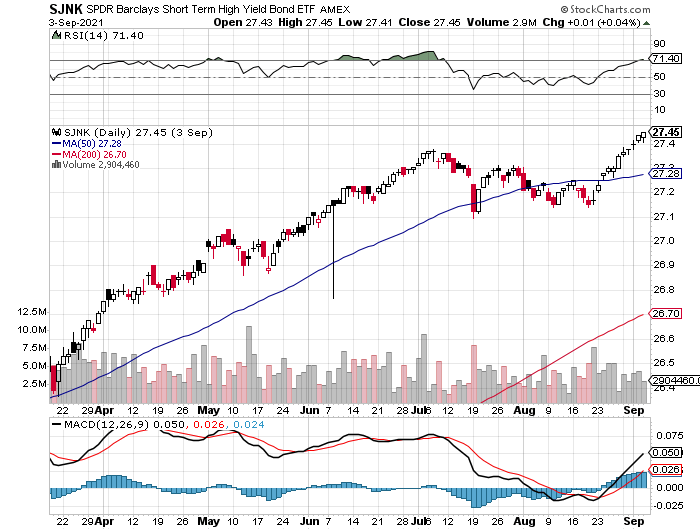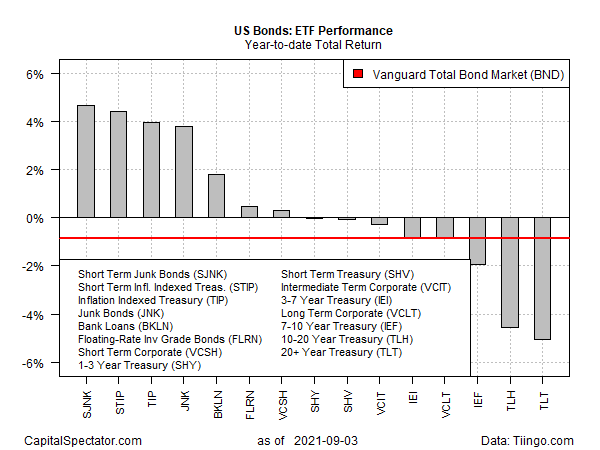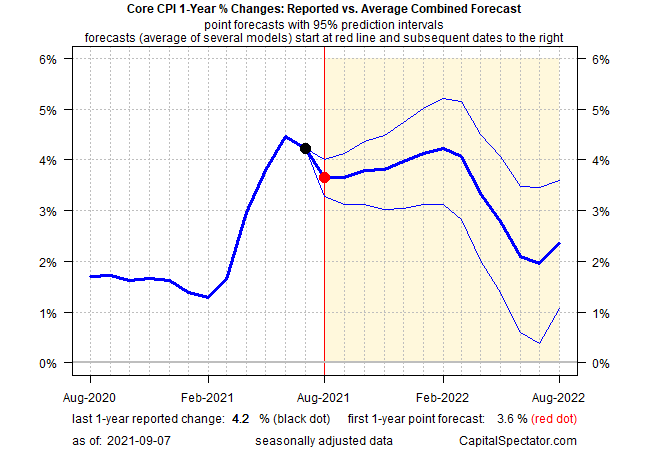Uncertainty remains elevated for the economy, inflation, monetary policy and the path of the pandemic as the final quarter of 2021 approaches. As investors struggle to get a handle on how the final run of 2021 plays out, the US bond market has delivered a mixed performance year to date, based on a set of ETFs through Sep. 3.
Several narratives are roiling expectations. On the one hand, the risk of slower growth and disinflation continue to churn, driven by a rebound in the pandemic, the fading of federal stimulus support, and other factors. Meantime, investors worry that the recent jump in inflation will persist—an outlook that the Federal Reserve says is a low-risk event.
Meanwhile, unusually low interest rates are pushing investors to search for yield in junk bonds. Although spreads on junk bonds relative to Treasuries are close to the lowest in decades, the appetite for higher yield is throwing caution to the wind.
Leading the winners in this year’s bond-market race: junk bonds and inflation-indexed government securities. On the flip side, long-maturity corporates and Treasuries are deep in the red.
The top performer on our list: SPDR Bloomberg Barclays Short Term High Yield Bond (NYSE:SJNK), which is up 4.7% on a total return basis this year. Notably, SJNK has been on a tear recently: the ETF posted its eleventh straight daily advance at last week’s close.

Running a close second for US bond performance in 2021: short-term Treasury Inflation Protected Securities, a.k.a. TIPS. The iShares 0-5 Year TIPS Bond ETF (NYSE:STIP) is sitting on a 4.4% gain so far this year.

More than half of our proxy bond ETFs are nursing losses this year. The deepest decline: iShares 20+ Year Treasury Bond (NASDAQ:TLT) has shed 5.1%.
A negative bias is clearly blowing for investment-grade bonds generally, based on the market benchmark: Vanguard Total Bond Market Index Fund ETF Shares (NASDAQ:BND) is down 0.9% in 2021.
Some analysts recommend keeping expectations muted. “The Treasury market will remain in this sort of lull,” predicts Bill Herrmann at Wilshire Phoenix LLC. “The labor data points to fears of delta, which all may turn out to be just fears, but we can only go on the data that we are presented with. It’s looking really likely that the Fed is going to be handcuffed against normalizing policy at all until delta is contained.”
The near-term outlook may be dull, but the crowd’s appetite for Treasuries remains robust, reports The Wall Street Journal: “Investors keep buying U.S. Treasury securities, defying predictions for a broad selloff that would send bond yields back to their March highs.”
A key factor for bond market performance for the rest of the year: inflation. But the outlook is cloudy – more so than usual – as debate rages on whether the recent surge in inflation is transitory or marks the start of an extended run of higher pricing pressure.
“Financial markets continue pricing in both that the inflation will prove transitory and that policymakers will barely need to budge in response. We see this potential combination of outcomes as unlikely,” counsels Rebecca Patterson, director of investment research at Bridgewater Associates.
A reality check arrives next week (Sep. 14) with the release of US consumer price inflation for August. Although it’s premature to dismiss the possibility that inflation could run hotter for longer than expected, the possibility that pricing pressure will ease shouldn’t be dismissed either.
Consider, for instance, that The Capital Spectator’s combination forecasting model is projecting that the one-year change for core CPI will drop for a second month to 3.6% from 4.2% previously. If the forecast is correct, more or less, the news will boost the case for expecting inflation to ease. By contrast, an upside surprise would likely take a deeper bite out of bonds, particularly at the long end.

